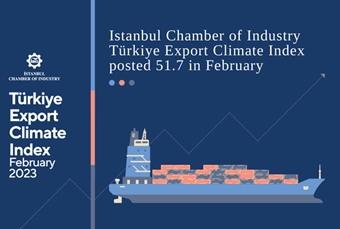ICI Türkiye Export Climate Index Rose to 51.7 in February
- 08.03.2023
- News

Measuring the operating conditions in the key export markets of the Turkish manufacturing sector, the Istanbul Chamber of Industry (ICI) Türkiye Manufacturing Export Climate Index rose to 51.7 in February, above the 50.0 no-change mark, pointing to the first improvement in output and export demand conditions on monthly basis since June 2022.
The improvement in the index was mostly due to the signs of recovery in important export markets such as Europe and the US, and the strong growth continuing in some parts of the Middle East.
The Istanbul Chamber of Industry (ICI) Türkiye Manufacturing Export Climate Index, which measures the operation conditions in the key export markets of the Turkish manufacturing sector, announced the results of the index for February 2023. In the index, the figures above the 50.0 no-change mark signals an improvement in the export climate, while the figures below signals a deterioration.
The Istanbul Chamber of Industry (ICI) Türkiye Manufacturing Export Climate Index rose to 51.7 in February from 49.5 in January, above the 50.0 no-change mark, pointing to the first improvement in output and export demand conditions on monthly basis since June 2022. In the last months of the last year there were output contractions in the US and in most of the European economies. But the latest data showed a positive return in these important export markets.
The US saw the first increase after seven months, many European markets posted growth
The economic activity in the US recorded growth in February after a seven-month decline. Similarly, many European markets started to grow. In Germany, the largest export market for the Turkish manufacturing products, the output increased for the first time in the last eight months. In the United Kingdom and France, contraction periods ended after six months and four months, respectfully, returning to growth zone.
The recovery trend continued in Italy and Spain. Both economies saw growth in output for two consecutive months, higher than January. The economic activity in Russia also recorded an increase for the first time since September last year.
The Middle East was the main source of growth in demand, China continued to recover
The Middle East continued to be the main source of the growth in demand in the first quarter. The growth accelerated in both the United Arab Emirates and the Saudi Arabia. Qatar returned to growth zone, while contraction in Egypt and Lebanon decelerated. China continued to recover economically as the pandemic restrictions have been lifted. It saw growth in output for two consecutive months with the fastest pace since June last year. The sharpest contraction in the monitored economies in February was in Nigeria, where cash problems significantly affected the economic activities negatively. The output in this country dropped with a highest rate since the start of the Covid-19 pandemic.
Commenting on the Istanbul Chamber of Industry Türkiye Manufacturing Export Climate Index, Andrew Harker, Economics Director, S&P Global Market Intelligence, said: “More positive outlook in the global economic environment at the beginning of 2023 compared to the end of 2022 and to the expectations supported the Turkish manufacturing exporters. The promising development of the last survey period was the return of the important European markets and the US to growth zone. And China's reopening would help the global demand to get stronger in the next months.”
You can find attached the Istanbul Chamber of Industry Türkiye Export Climate Index February 2023 reports.